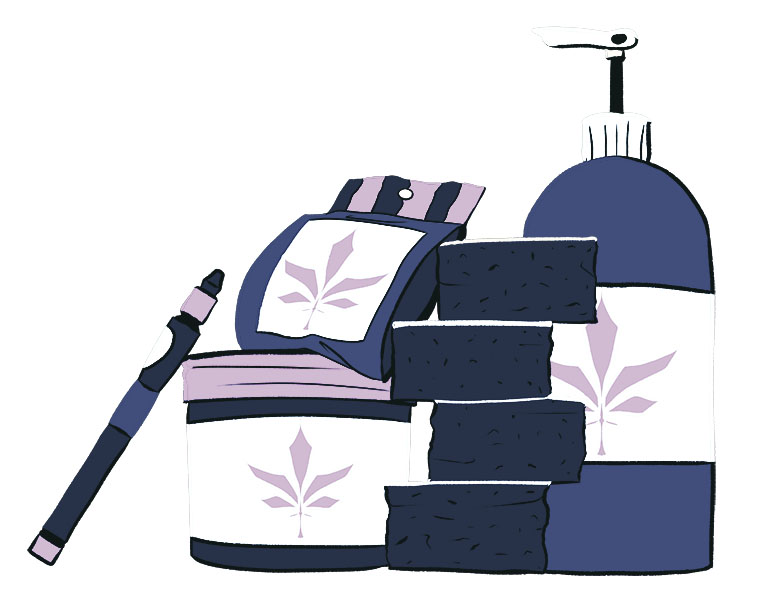On Oct. 17, 2019, consumable pot products, like edibles, vapes, and topicals, entered the legal, recreational market in Canada, one year after the legalization of dried flower (or buds). However, it takes up to 60 days for products to go through the slow, methodical regulation process of Health Canada, so products were not officially available for purchase until Dec. 17, 2019. Studies are estimating the entire market will be worth close to $2.7 billion by next year.
While these products are appealing to new, cannabis-curious customers, legal dispensaries are finding it hard to compete with the illicit market because of strict product regulations. The legal dose of THC (the psychoactive ingredient in cannabis) per edible serving is limited to 10 mg, which is not enough to have an effect on long-time users, due to their high tolerance to THC. The products in the illicit market are often much cheaper and more potent than products sold in legal dispensaries.
Chelsea Smith is the former managing director of Motacan Compassion Society, a medicinal cannabis dispensary in Abbotsford.
“When it comes to the edible, the biggest issue I’ve been hearing is that it’s really expensive and you really don’t get your money’s worth when you’re comparing it to how the industry was before legalization,” said Smith. “There were a lot of companies that were trying to battle for the best bang for your buck, making it super effective for people who needed relief. It’s good for the people who are starting out … but I think when it comes to the general demographic there should be more availability when it comes to strengths and costs essentially.”
Here are a couple things you should know about these newly legal products to have an enjoyable and safe experience:
Edibles: Smith advised: “Start low and go slow … You can always take more of something but you can’t go back in time and take less.”
Edibles can take from 30 minutes up to four hours for you to feel their full effect. Therefore it is necessary to start with a very low dose, such as 5 mg. As well, never mix alcohol and cannabis products.
If you feel as if you consumed too much, try some CBD oil, which may counteract the psychoactive effects of the THC, stay hydrated, don’t panic, and try to sleep it off.
Topicals: Topicals are cannabis-infused skincare products such as lotions, balms, massage oil, and bath salts. Topicals are used for pain relief and typically don’t get you high.
“Topicals are fantastic and a really good thing to introduce to someone who has never used a cannabis product before,” said Smith. “It’s nice because it stays local to the area that you are applying to, which makes it a really nice product for seniors who are dealing with arthritis, or someone who is dealing with a work-related injury.”
If you are using topicals and want to avoid any psychoactive effects, be sure to wash your hands thoroughly after applying the product to your skin, and be sure to not apply to any broken skin.
Vaporizers: Vaporizers can be filled with reloadable cartridges, concentrates, or dried flower, and are an easy and discreet way to consume marijuana as the vapour is odourless and pens are portable and heat up in a few seconds.
“I think overall THC vaping is a great idea, especially when it comes to pens you can control the temperature with,” said Smith. “Sometimes vapes are just way too hot and can potentially cause more discomfort than relief. But they are a great option for people who want to medicate discreetly.”
There has been a lot of concern about vaping recently, as vaping-related illnesses have caused the deaths of 60 people in the U.S. as of Jan. 14, 2020. However, the vape pens and cartridges that you buy at legal dispensaries are all vetted by Health Canada as safe to use. However, Health Canada has only tested the effects of the vaping liquids, and not the vapour itself. Health Canada said in a statement to CBC News that “Providing legal access to strictly regulated cannabis products is one of the best ways to protect Canadians from the risks posed by products from the illegal market, which are not subject to any standards, testing, or oversight for safety or quality.”
So my friends, stay safe and enjoy your freedom to medicate recreationally as a resident of the True North strong and free.
Illustration: Kayt Hine
Andrea Sadowski is working towards her BA in Global Development Studies, with a minor in anthropology and Mennonite studies. When she's not sitting in front of her computer, Andrea enjoys climbing mountains, sleeping outside, cooking delicious plant-based food, talking to animals, and dismantling the patriarchy.


